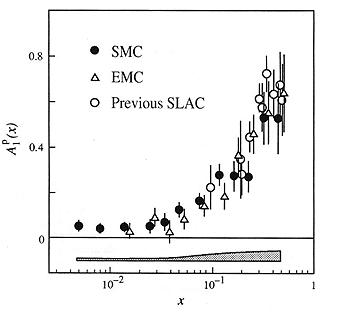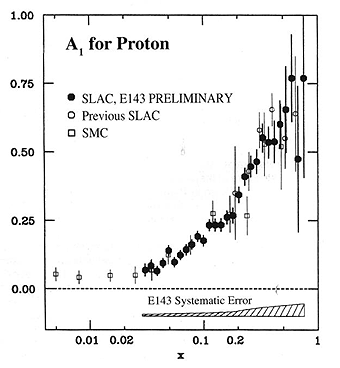


An extensive experimental programme was therefore immediately proposed at CERN, SLAC (Stanford) and DESY (Hamburg) to measure the spin structure function of the neutron and to repeat the proton measurement with improved accuracy.
After five years of intense experimental activity, incisive new data have been recently obtained in Europe at CERN and in the United States at SLAC. The situation was summarized recently at the fifth "Conference on the Intersections of Particle and Nuclear Physics", held at the beginning of June in St. Petersburg (Florida). The spin structure has been measured for the proton, the neutron and the deuteron. New CERN and SLAC proton data were presented which confirm, with significantly increased precision, the initial results and underline the enigmatic spin structure of the proton.
Experiments with unpolarized lepton beams and targets average over all the possible orientations of quark spins in the nucleon or nucleus. To measure the fraction of the nucleon spin carried by the quark spins, one must orient the spins of the incoming lepton and of the target nucleon, so that the lepton and nucleon spin are either parallel or antiparallel to each other.
Electron and muon data are complementary: electron data have high statistical accuracy in a limited xrange (momentum fraction carried by the struck quark), while muon data have lower statistical accuracy but extend to significantly lower x and higher momentum transfer (Q2) Systematic uncertainties are similar. A combined analysis of electron and muon data exploits the relative strengths of the two types of experiments.
Polarized muon-nucleon scattering experiments are carried out at CERN by the Spin Muon Collaboration (SMC), using beams of 100-200 GeV muons. To compensate for the relatively small number of muons in the beam, a very thick polarized butanol target has been designed and built. To cancel to a large extent systematic uncertainties, the target consists of two cells with opposite longitudinal polarizations, inserted in a superconducting magnet of 2.5T. Both cells are 60cm long and 5cm in diameter, separated by 30cm. It is by far the largest polarized target in the world. Nucleon spins are oriented in the direction of the beam by dynamic nuclear polarization and then frozen at 30mK using a helium3/helium4 dilution refrigerator. SMC measured the spin structure of the deuteron in 1992 and of the proton in 1993. The measurements on the proton cover now a wide x range, from 0.003 to 0.7 and improve significantly the experimental accuracy of the proton data.
Several experiments are in progress at SLAC. In 1992 the E142 experiment measured the spin structure of the neutron with a helium-3 target in the x range 0.030.6. The E143 experiment, which used NH3 and ND3 as proton and deuteron targets respectively, took data at the end of 1993. These targets are polarized using the same principle as is used in the SMC target. The E142 and E143 experiments used electron beams of energies up to 30 GeV. The development of strained gallium arsenide crystals (July/ August 1993, page 5) increased the polarization of the electron beam in 1993 from 40% to 90% and made it possible to reach a remarkable statistical accuracy. Proton and deuteron data have been measured by the E143 collaboration in the x range 0.027 to 0.7. As well as impressive statistical accuracy (10^8 events for proton longitudinal spin data) due to the high SLAC electron flux and polarization, systematic uncertainties are reduced by random fast reversals (120Hz) of the spin orientations of the electrons in the incident beam.
The surprising EMC results observed in 1988 are now confirmed with an increased precision by the recent SMC and E143 proton data. The combined analysis of all the existing proton and neutron data show that they are consistent with each other and corroborate to within 10% the theoretical prediction of J.D. Bjorken for the proton and neutron difference .
When quark-gluon field theory (QCD) corrections are taken into account, the analysis of all published data indicates that quark spins account for only about 30% of the nucleon spin. The origin of the remaining fraction of the spin is not yet understood. Taken at face value, the recent SMC and E143 data indicate a significant contribution to the nucleon spin from the strange quarks and antiquarks with a net polarization opposite to that of the nucleon. This disagrees with the predictions of naive quark models, such as those proposed 20 years ago by J. Ellis and R. Jaffe as a benchmark for the subsequent data.
One possible interpretation is a large contribution from the AdlerBellJackiw "axial anomaly" by which a quantum effect destroys a classically conserved current. This effect is expected to be small unless there is a large gluon polarization. The small quark spin fraction and the polarization of the strange quark sea can alternatively be explained naturally in a class of approximate models of QCD in which the spin-1/2 nucleon corresponds to a sort of "knot" in the field of pions (topological soliton). Thus, to understand the spin structure of the proton, one has to take into account an unexpectedly large effect of either the gluon spins or the orbital angular momentum of quarks and gluons.
Publication of the complete E143 results on the accurate comparison of the proton and deuteron is expected in the near future. SMC will take new data on the deuteron this year and on the proton next year. At SLAC, two new experiments, E154 and E155, are planned to measure the proton, the deuteron and helium 3 spin structure in the fall of 1995 with a 50 GeV electron beam, the highest available electron energy. The experimental approach proposed by the HERMES collaboration at DESY, Hamburg, involves a novel technique based on a polarized atomic gas target in the polarized electron bean. circulating in the HERA machine. Its main advantage is the high purity of the polarized atomic gas target, and high statistics. HERMES plans to take its first data next year.
 peter@neuro.hut.fi
peter@neuro.hut.fi3-APR-95